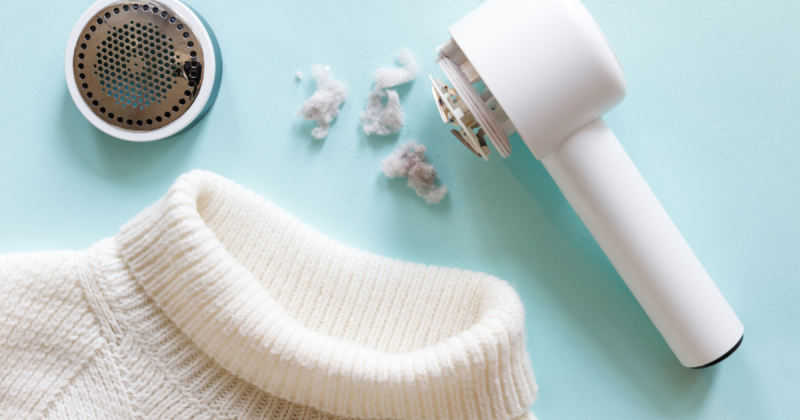Few things are frustrating than putting on a freshly washed outfit, only to find it covered in lint. These tiny fibers can make even well-maintained clothing look unkempt, making it challenging to achieve lint-free clothes. Lint is unavoidable in fabric care, whether caused by washing, static buildup, or daily wear. The good news? There are expert-approved methods to remove lint effectively and prevent it from accumulating. In this blog, we’ll explore the causes of lint, the best ways to eliminate it, and how to keep your clothes looking fresh and lint-free. Our insights come from laundry, cleaning, and fabric professionals, ensuring you get the most reliable advice.
Understanding Lint & Pilling
What is Lint?
Lint comprises tiny loose fibers that shed from fabric and attach to clothing. It’s often accompanied by dust, pet hair, and other debris. Lint is especially noticeable on dark-colored clothing and certain fabric types, such as wool, fleece, and synthetic blends.
Lint vs. Pilling
While lint refers to loose fibers sticking to the fabric’s surface, pilling is different—it occurs when fibers bunch up and form small, knotted balls. Pilling is caused by repeated friction, such as washing, drying, and everyday wear. Unlike lint, which can often be brushed off, pilling requires more aggressive removal methods like shaving or abrasion.
What Causes Lint Buildup?
Lint accumulation happens due to:
- Friction: Wearing, washing, and drying clothes cause fibers to shed and attach to the fabric.
- Static Electricity: Dry environments increase static, making lint cling more stubbornly.
- Fabric Type: Some materials, like wool and fleece, naturally shed more than others.
Now that we understand lint, let’s explore the best ways to remove it.
Lint removal can be frustrating, but keeping your clothes lint-free is simple with the proper techniques. There are various methods to remove lint, including adhesion-based tools, abrasion-based methods, and other practical solutions. Each method has its advantages and works best for different fabric types. Below, we’ll explore these techniques in detail, explaining how each works and its effectiveness.
Adhesion-Based Methods
1. Lint Rollers
A lint roller is a must-have tool for quickly and effectively removing lint from clothing. The standard version features sticky sheets that pick up lint as you roll it across the fabric. Once the top sheet is full, peel it off to reveal a fresh adhesive layer. Reusable lint rollers, often made from silicone, provide a more sustainable option and can be washed and reused multiple times. Whether you choose a disposable or reusable version, a lint roller is excellent for daily lint management.
2. Homemade Lint Roller
If you don’t have a lint roller, you can easily create a homemade version using packaging tape and a rolling pin. Wrap the tape around the rolling pin with the sticky side facing outward, ensuring it covers a good portion of the surface. Roll it over your clothes to effectively pick up lint, hair, and other debris. If you don’t have a rolling pin, substitute it with a water bottle or cylindrical object. This DIY approach is cost-effective and works well in emergencies.
3. Hand-Wrapped Tape Method
Another simple way to remove lint is by wrapping duct tape, painter’s tape, or packing tape around your hand. Press the sticky side against lint-covered areas and lift away the unwanted fibers. This method benefits small spots like collars, cuffs, or pockets. It’s also ideal for quick touch-ups when you’re in a hurry. However, avoid using firm adhesive tapes, which can damage delicate fabrics.
4. Masking Tape Strips
Masking tape works similarly to a lint roller but is best suited for smaller areas. Cut a strip of tape, press it onto the lint-covered fabric, and then peel it off to lift the lint. Repeat the process as needed until the area is clean. This method benefits hard-to-reach spots, such as seams or button areas. While effective, it may not be the best option for efficiently removing large amounts of lint.
5. Contact Paper
Contact paper is another adhesive-based solution that can be used similarly to tape. Cut a piece of contact paper and press it onto the lint-covered fabric to lift the fibers away. This method is helpful for large surfaces, such as coats or upholstery. However, it can be wasteful and expensive, as contact paper is not designed for repeated use. Additionally, its strong adhesive can sometimes leave residue on specific fabrics.
Abrasion-Based Methods
1. Scouring Pads
A slightly damp scouring pad can effectively remove lint, especially from wool and other textured fabrics. Gently scrub the affected area in circular motions to lift the lint from the surface. This method works well for deep-set lint that doesn’t come off quickly with a lint roller. However, it’s essential to use minimal pressure to avoid damaging delicate materials. Be sure to test on a small section of fabric before using it on an entire garment.
2. Pumice Stone
A pumice stone can be an excellent tool for removing pilling and stubborn lint, especially on heavy fabrics like wool. You can lift and remove lint clusters by gently rubbing the stone over the fabric. However, using this method cautiously is essential, as a pumice stone can be too abrasive for delicate materials. Overuse may also cause unnecessary fabric wear over time. If trying this technique, always apply light pressure and test on a small area first.
3. Electric Lint Shaver
An electric lint shaver is a convenient tool that effectively removes lint and pilling from clothing. It features a rotating blade that safely trims excess fibers from the fabric surface. This tool works well on sweaters, wool coats, and fleece garments that tend to develop pilling over time. Because it removes fabric fibers, using a lint shaver sparingly is essential to prevent thinning out the material. Follow the manufacturer’s instructions for optimal results.
4. Razor
A standard razor can effectively remove lint and pilling but requires extra care. Lay the fabric flat and lightly glide the razor over the lint-covered area in short strokes. The blade will trim off excess fibers, leaving the fabric smooth and lint-free. However, this method should only be used on durable materials, as razors can accidentally create holes in delicate fabrics. It’s best to use a light touch and avoid pressing too hard.
Other Effective Methods
1. Dryer Sheets
Dryer sheets help soften clothes, removing lint, and reducing static cling. Rubbing a slightly damp dryer sheet over fabric helps lift lint while neutralizing static electricity. This method works exceptionally well for synthetic fabrics, which attract lint more than natural fibers. Additionally, placing a dryer sheet in the laundry helps prevent lint buildup during washing and drying. Keep a few dryer sheets handy for quick touch-ups before heading out.
2. Wool Dryer Balls
Wool dryer balls are an eco-friendly alternative to dryer sheets and can help remove lint in multiple ways. When rubbed against dry clothing, they create friction that lifts away lint and fuzz. They also reduce static in the dryer, preventing lint from clinging to clothes. Since they are reusable, wool dryer balls are a cost-effective and sustainable solution. For best results, store them in a dry place and replace them if they start to wear out.
3. Rubber Gloves
Rubber gloves, such as those used for dishwashing, can be surprisingly effective at removing lint from clothing. Simply put on a pair of dry or slightly damp rubber gloves and rub them over the fabric. The texture of the gloves creates friction, helping to attract and lift lint. This method is beneficial for larger areas, such as coats and sofas. You can use latex gloves for a similar effect if you don’t have rubber gloves.
4. Nylon Stockings or Pantyhose
Old nylon stockings or pantyhose make excellent lint removers due to their smooth and slightly clingy texture. Simply stretch a stocking over your hand and rub it over the lint-covered fabric. The static created by the nylon will pull lint away from the material. This method is gentle enough for delicate fabrics like silk and cashmere. It’s also a great way to repurpose old stockings that might otherwise be discarded.
Lint Prevention Strategies
Removing lint is only half the battle—prevention is key to keeping your clothes looking fresh. Here are some expert-recommended strategies:
Washing Practices
- Wash lint-shedding and lint-attracting fabrics separately. Towels, fleece, and flannel shed lint, while materials like corduroy and velvet attract it.
- Turn clothes inside out. This reduces pilling and prevents lint from clinging to the outer surface.
- Add white vinegar to the rinse cycle. It helps prevent static and softens fabric (but may damage washing machine seals with frequent use).
- Empty pockets before washing. Forgotten tissues are notorious for leaving lint all over clothes.
- Wipe down the washing machine drum after washing lint-shedding items.
Drying Practices
- Shake clothes before putting them in the dryer. Loosens lint and prevents it from sticking during the drying process.
- Use dryer sheets to reduce static electricity. This prevents lint from clinging to clothes.
- Clean the dryer’s lint trap after every cycle. A clogged lint trap increases lint circulation inside the dryer.
- Consider air-drying clothes whenever possible. Air-drying reduces lint transfer and prevents static buildup.
Your Guide to Always Fresh, Lint-Free Clothes
Lint can be a stubborn nuisance, but it’s easy to remove and prevent properly. Adhesion-based tools like lint rollers and tape work well for quick fixes, while abrasion-based methods like fabric shavers and pumice stones help with more persistent lint and pilling. Proper washing and drying habits are essential for long-term prevention. Combining different techniques lets you keep your clothes lint-free and look their best. Try out these expert-approved solutions and see what works best for you!






